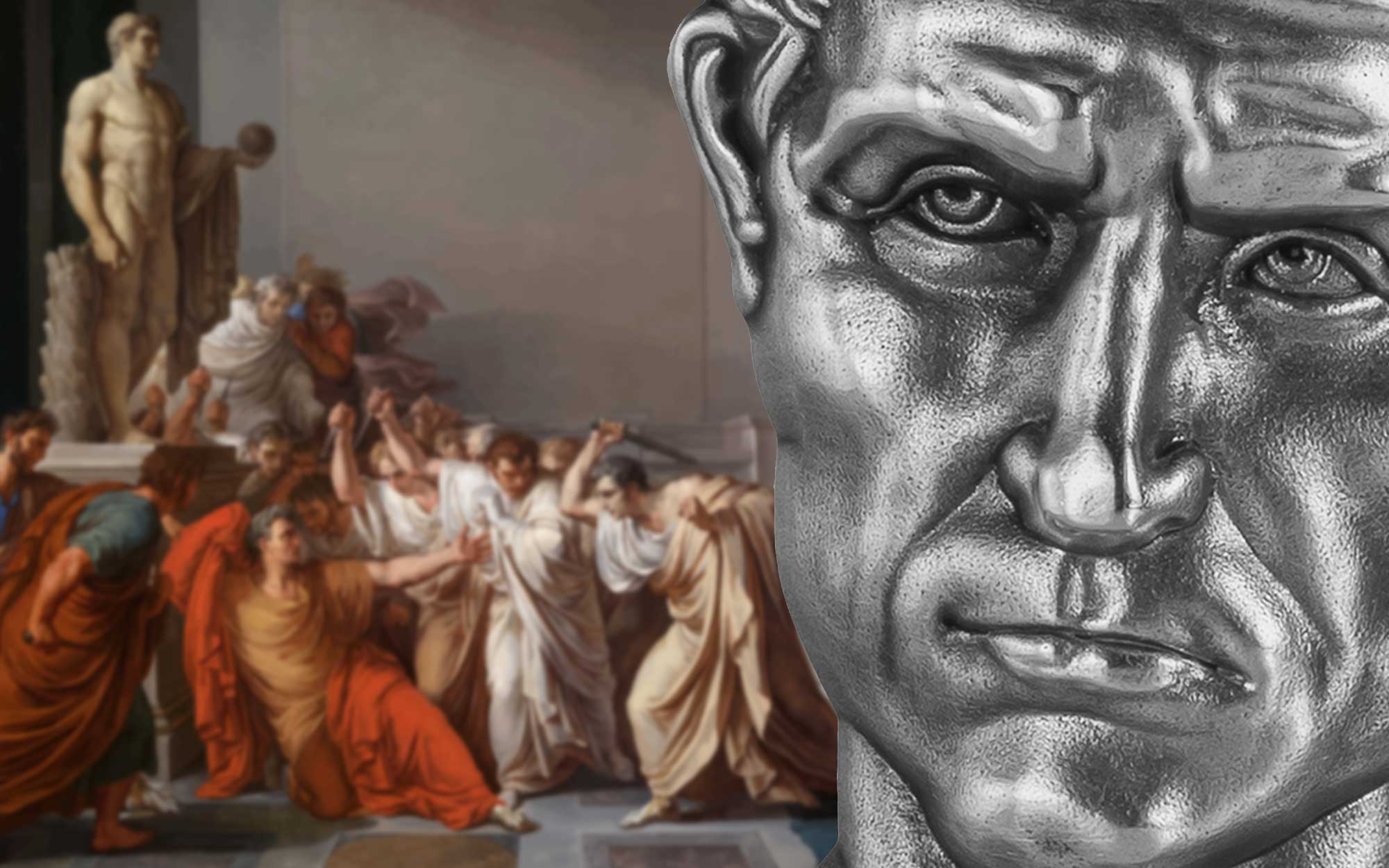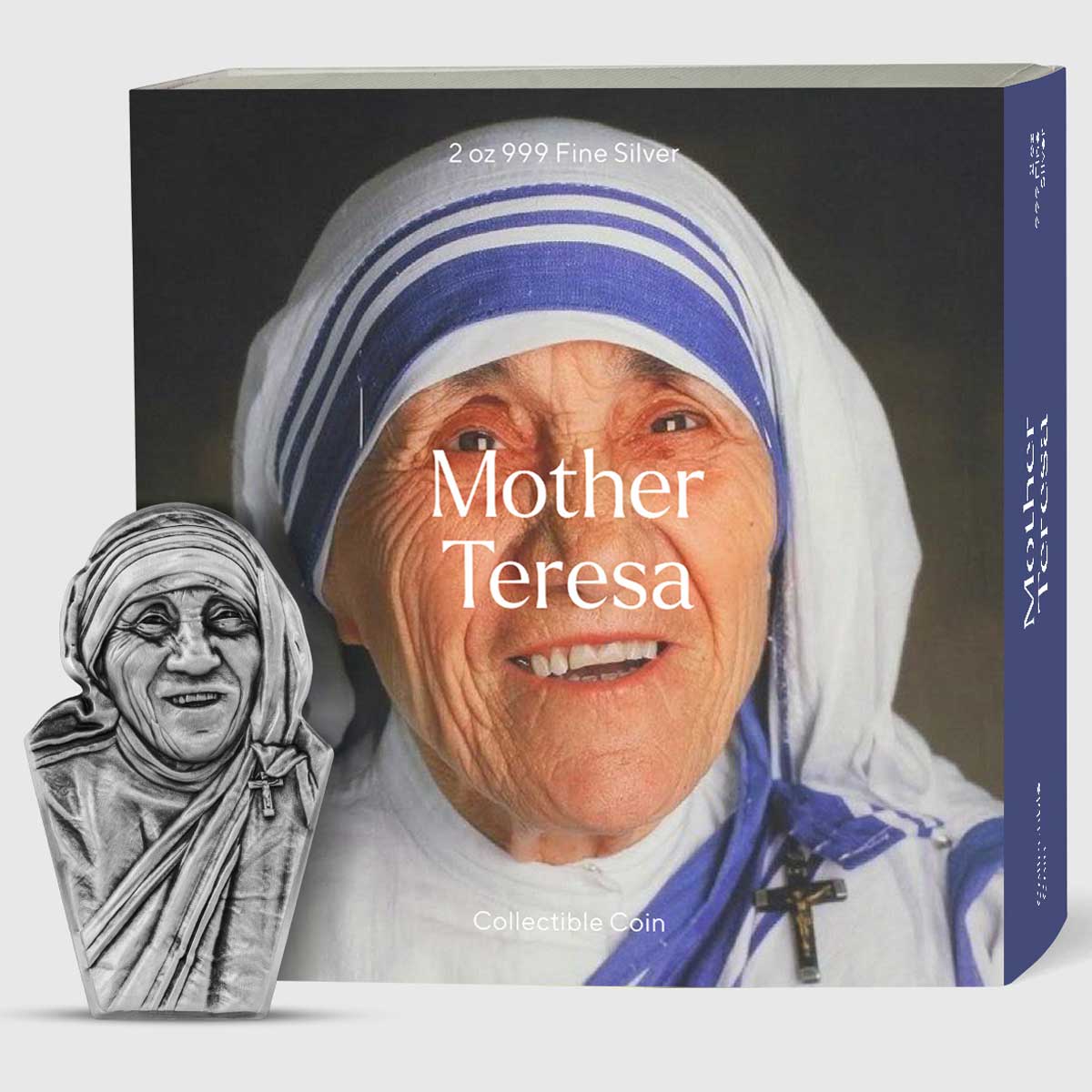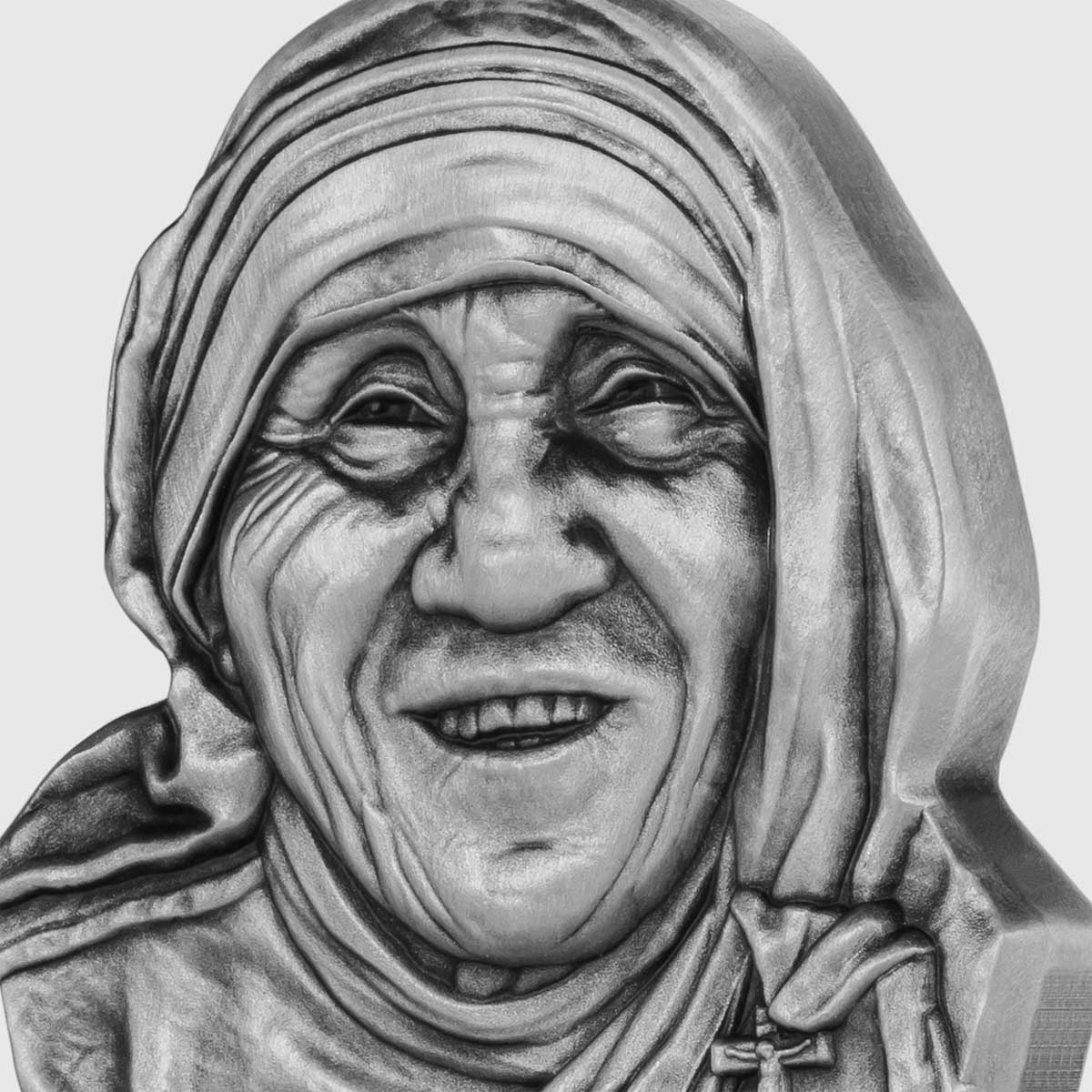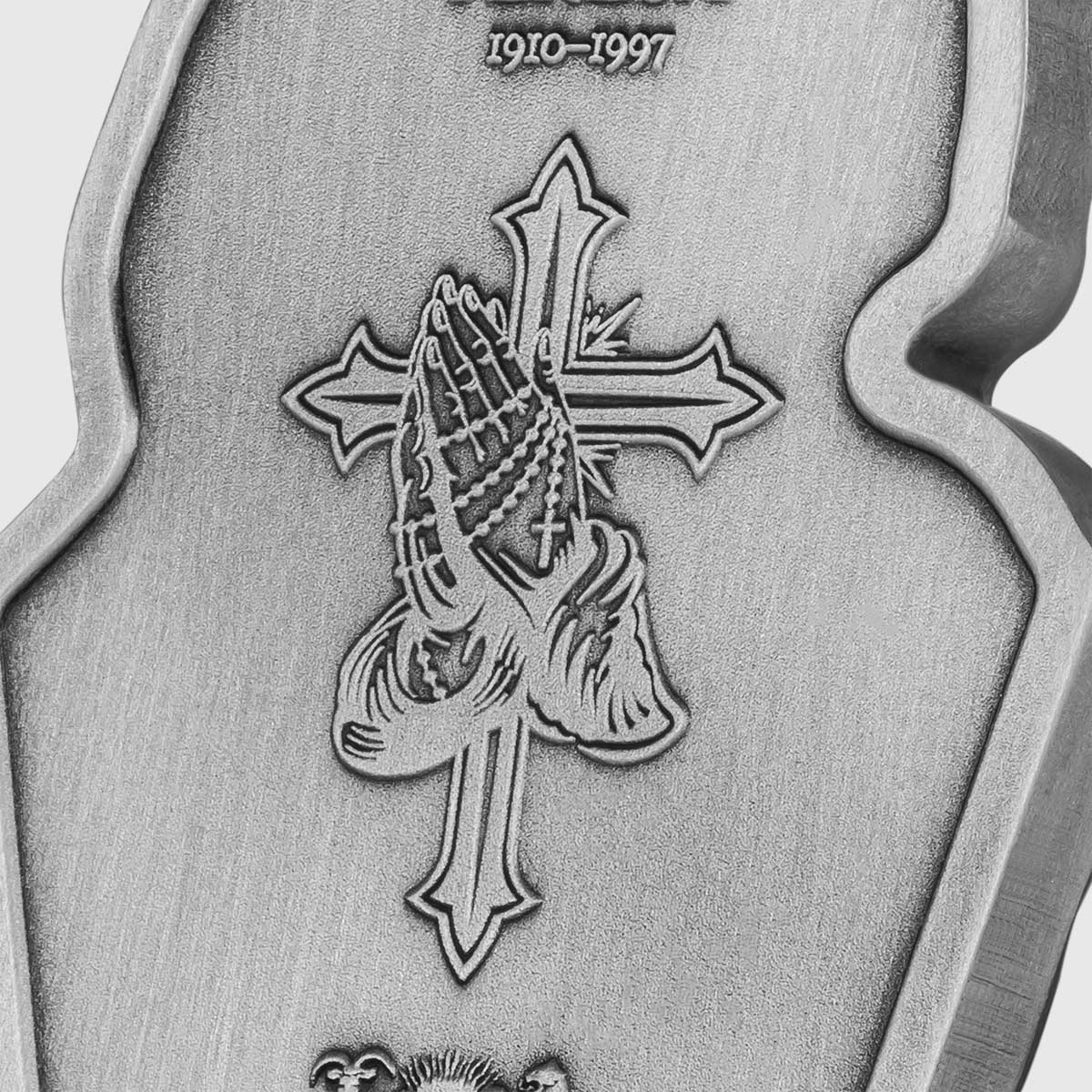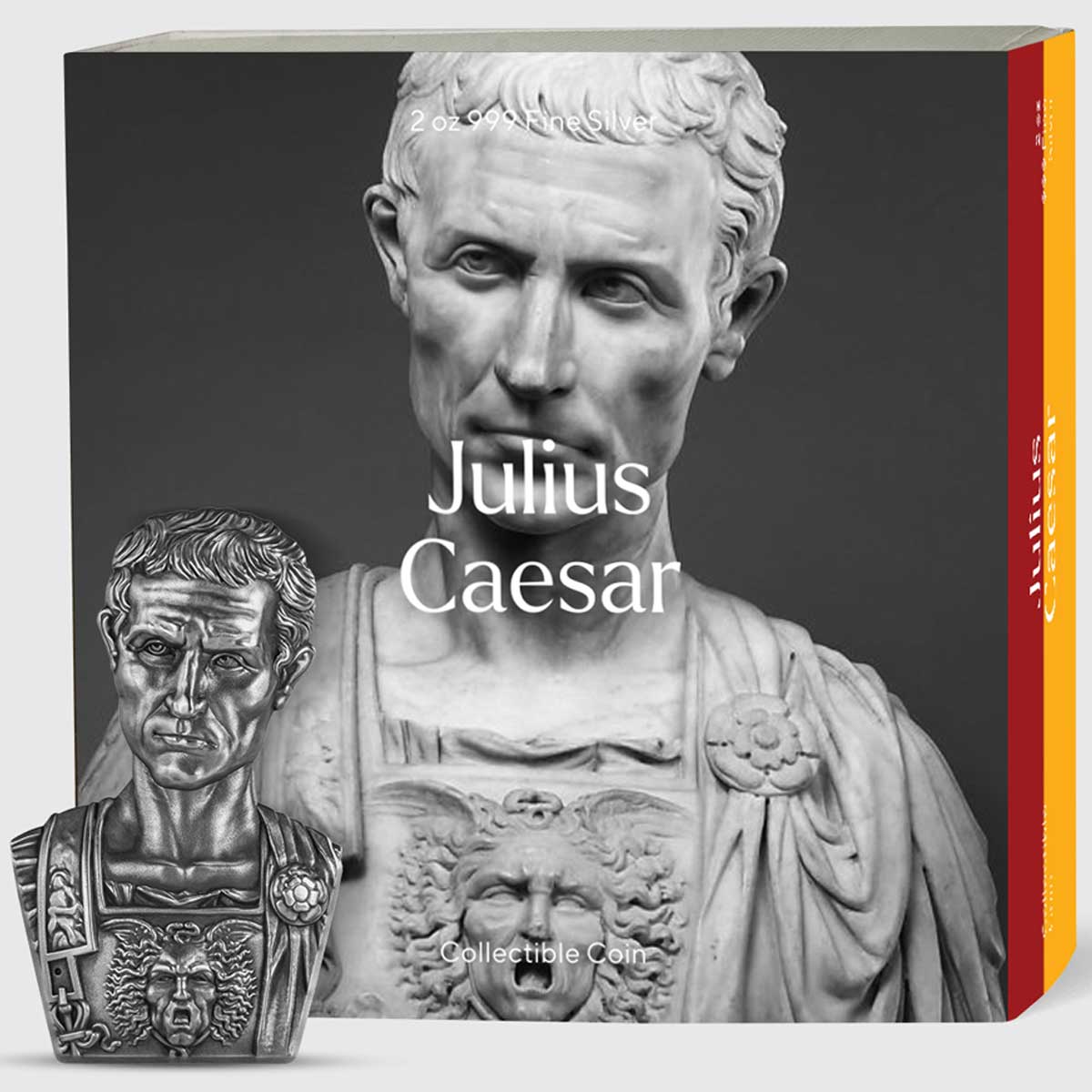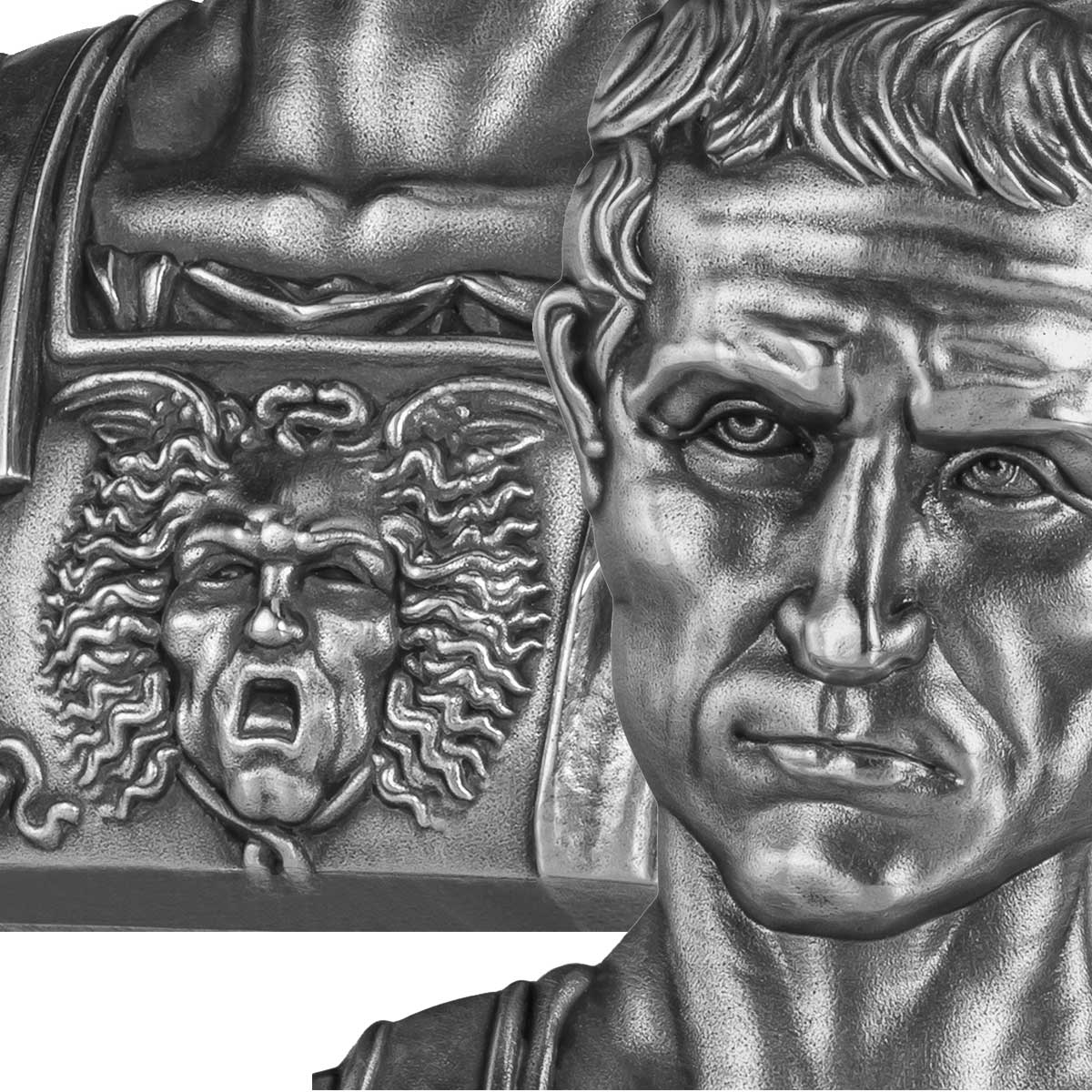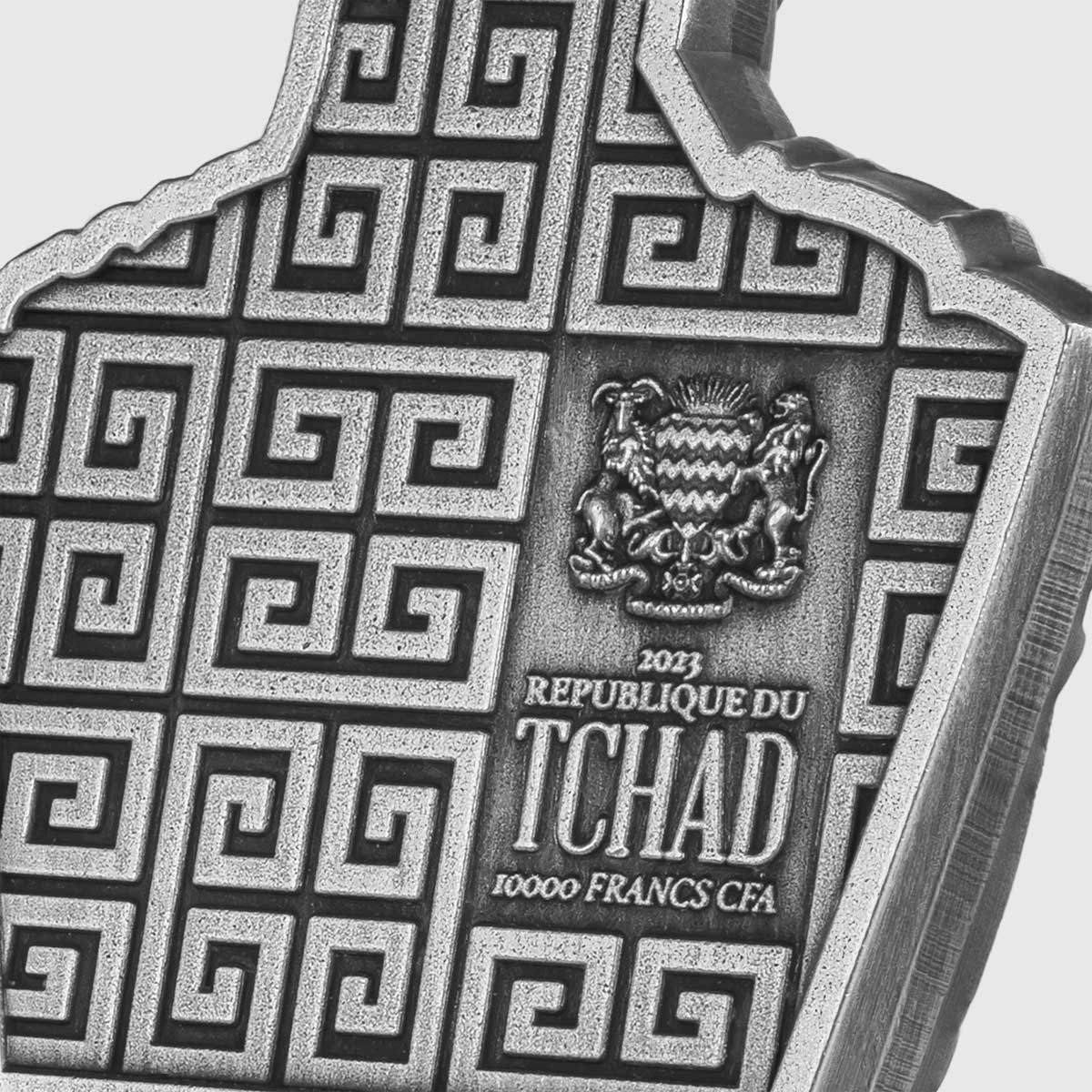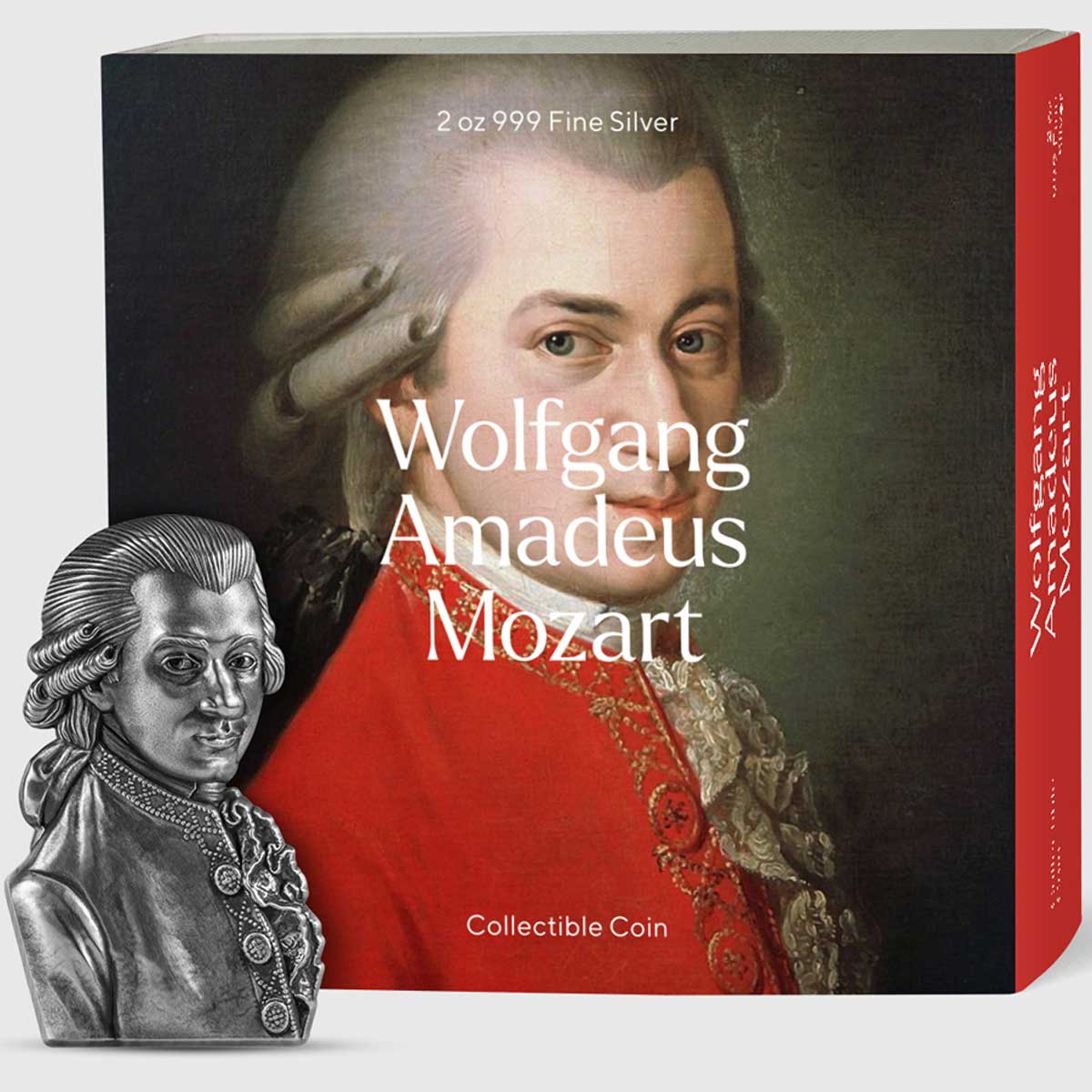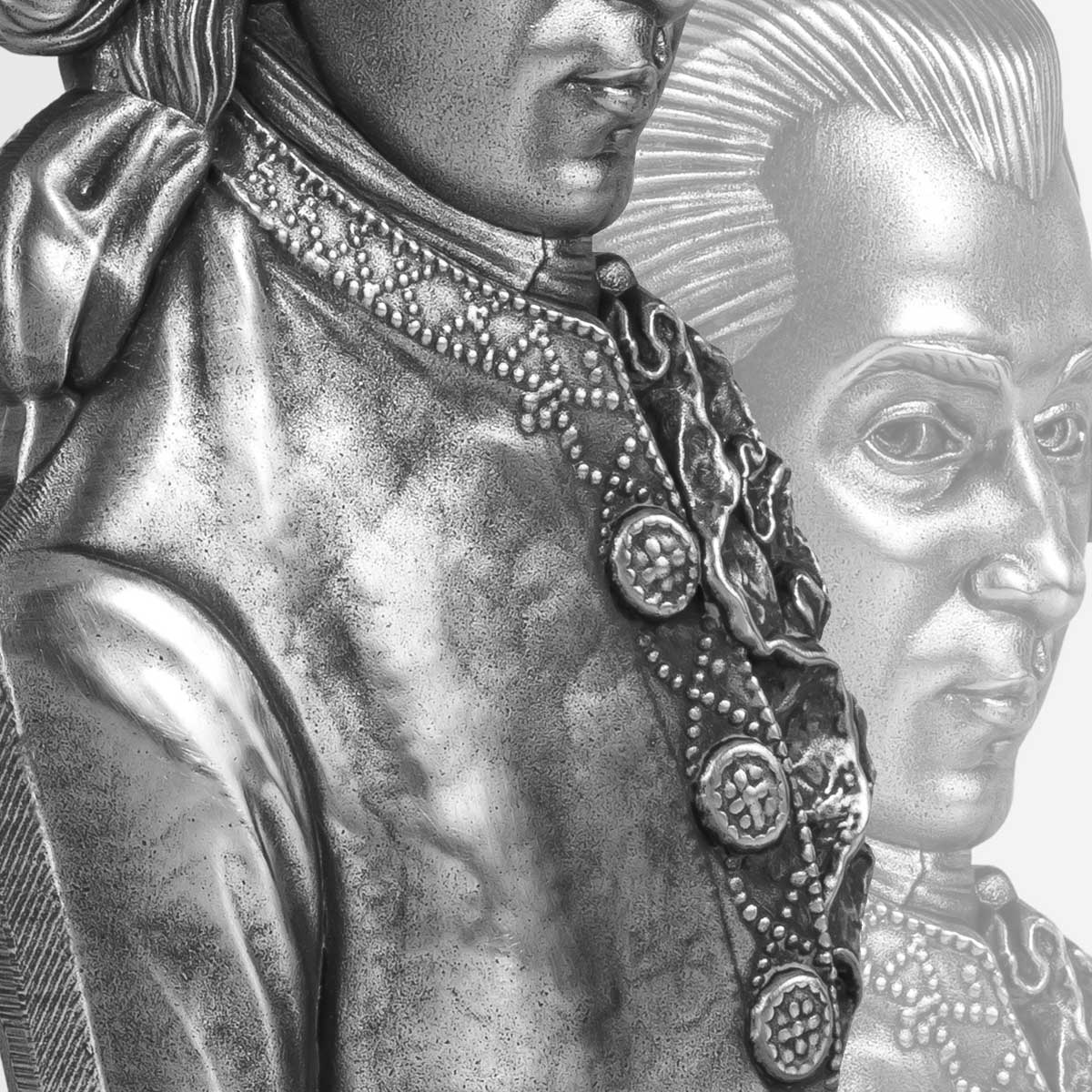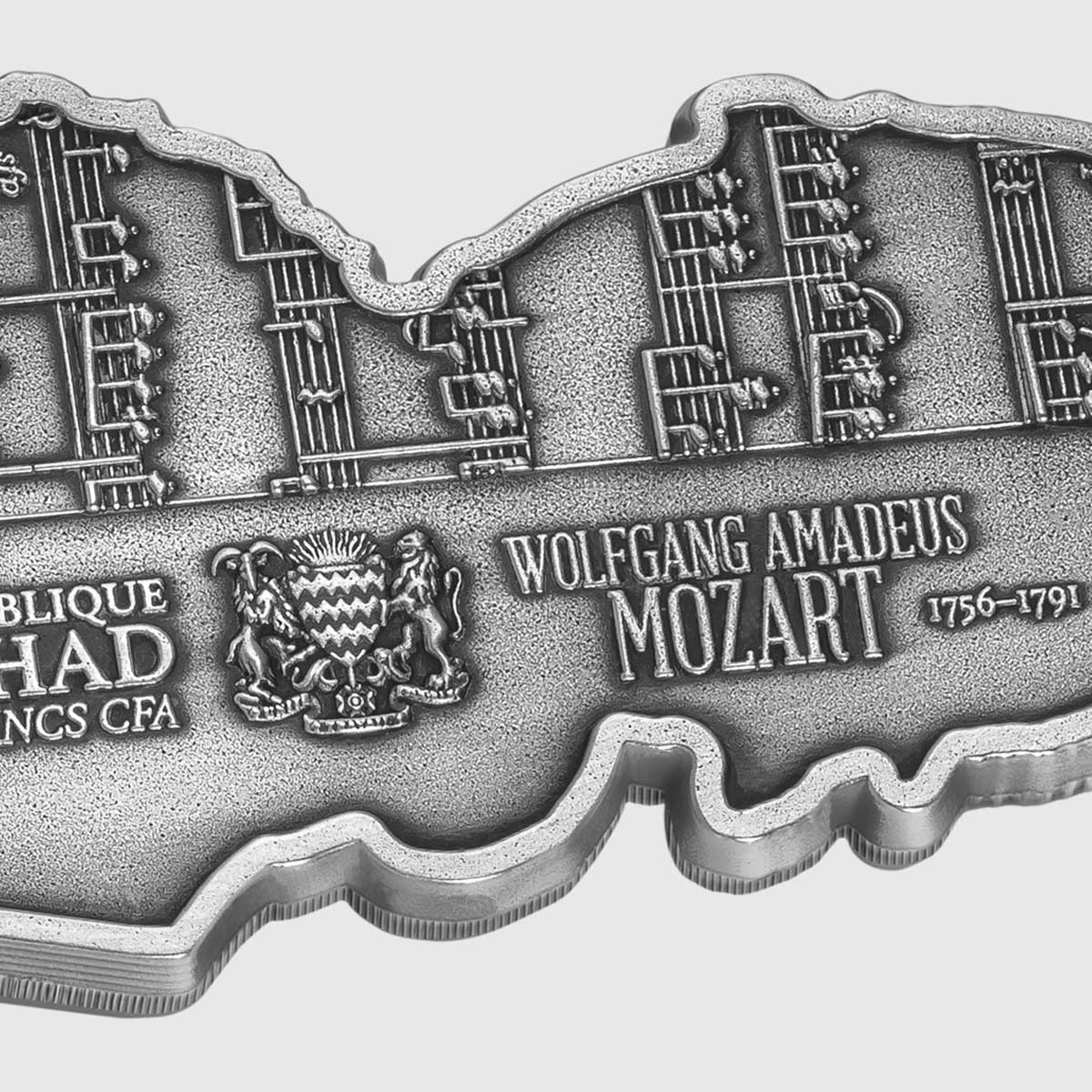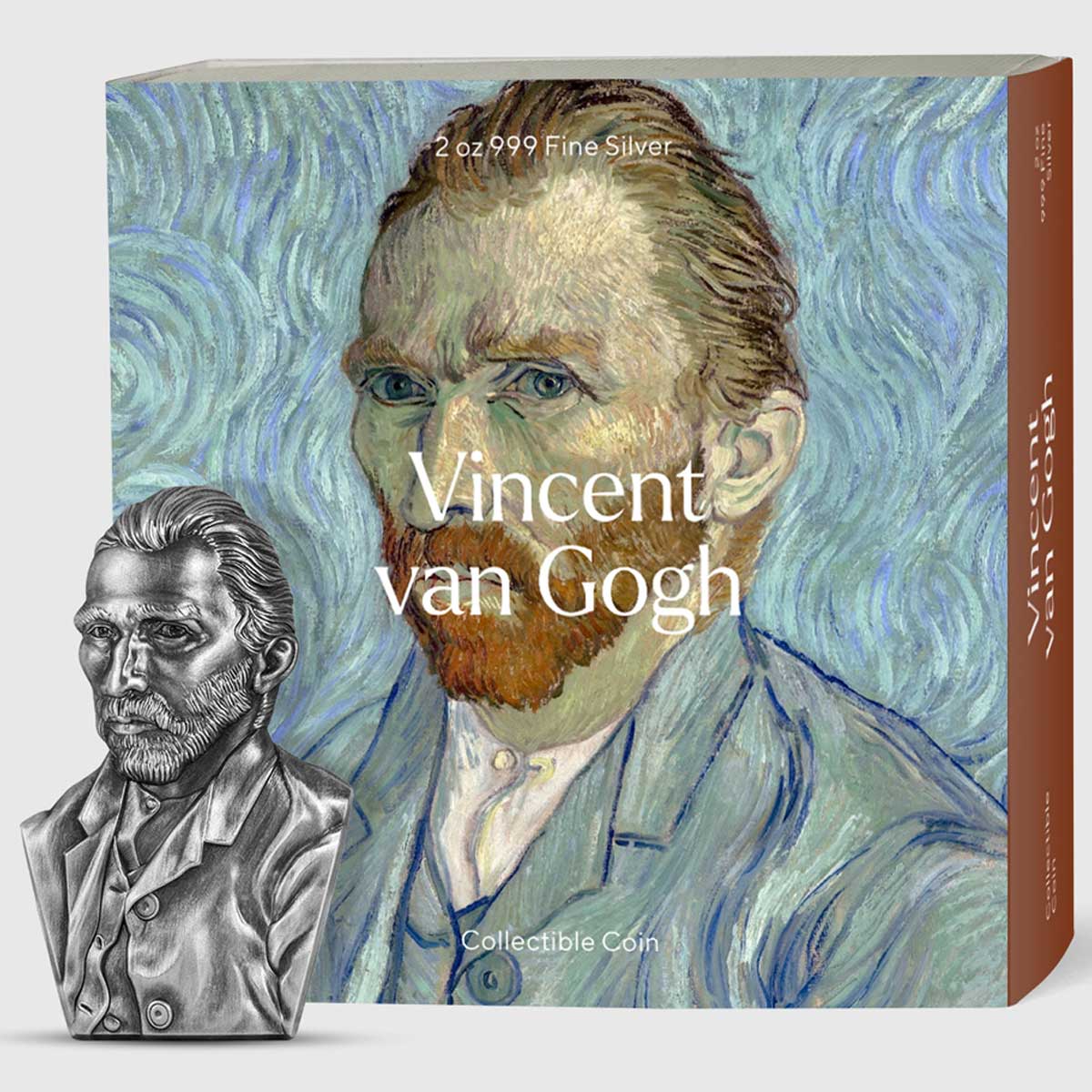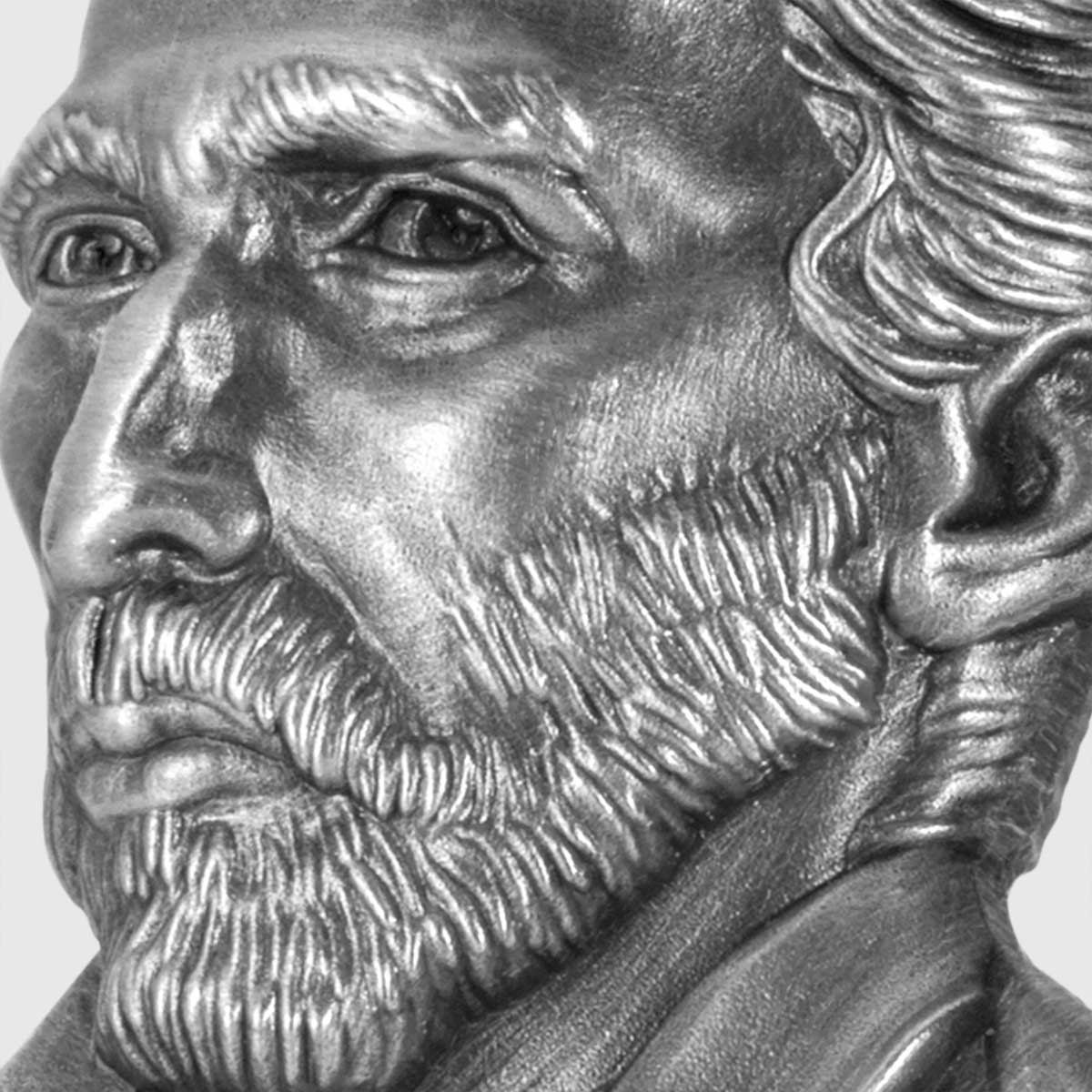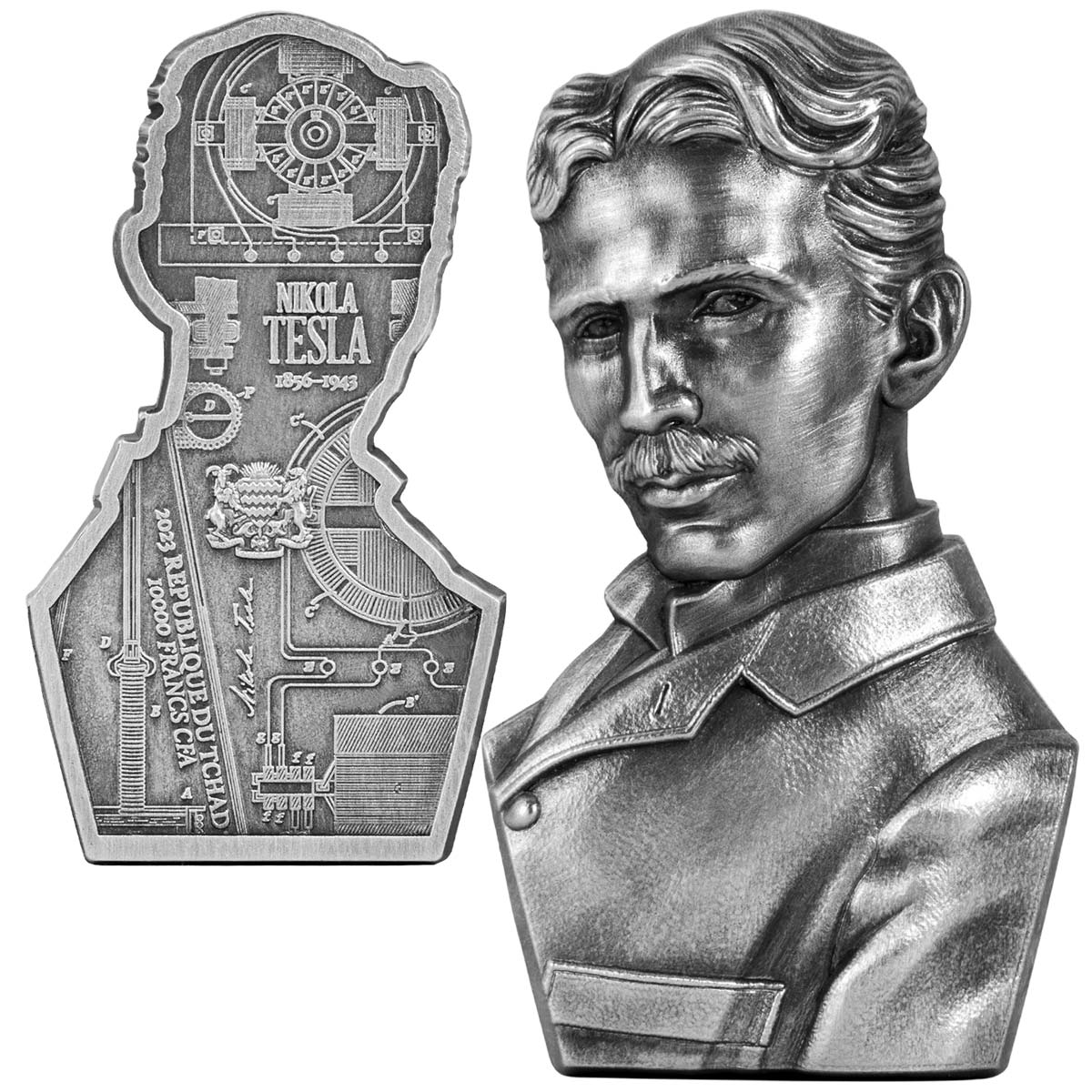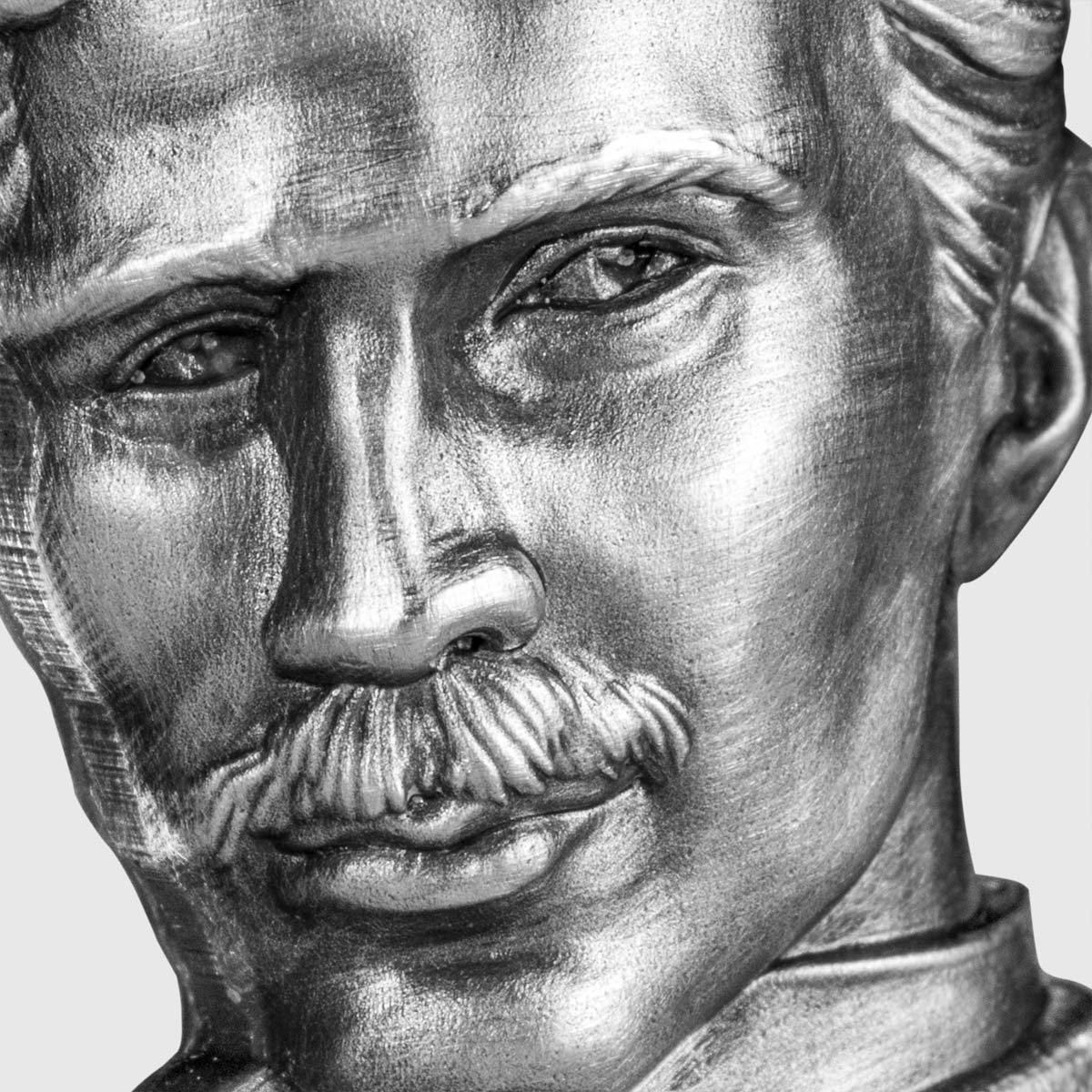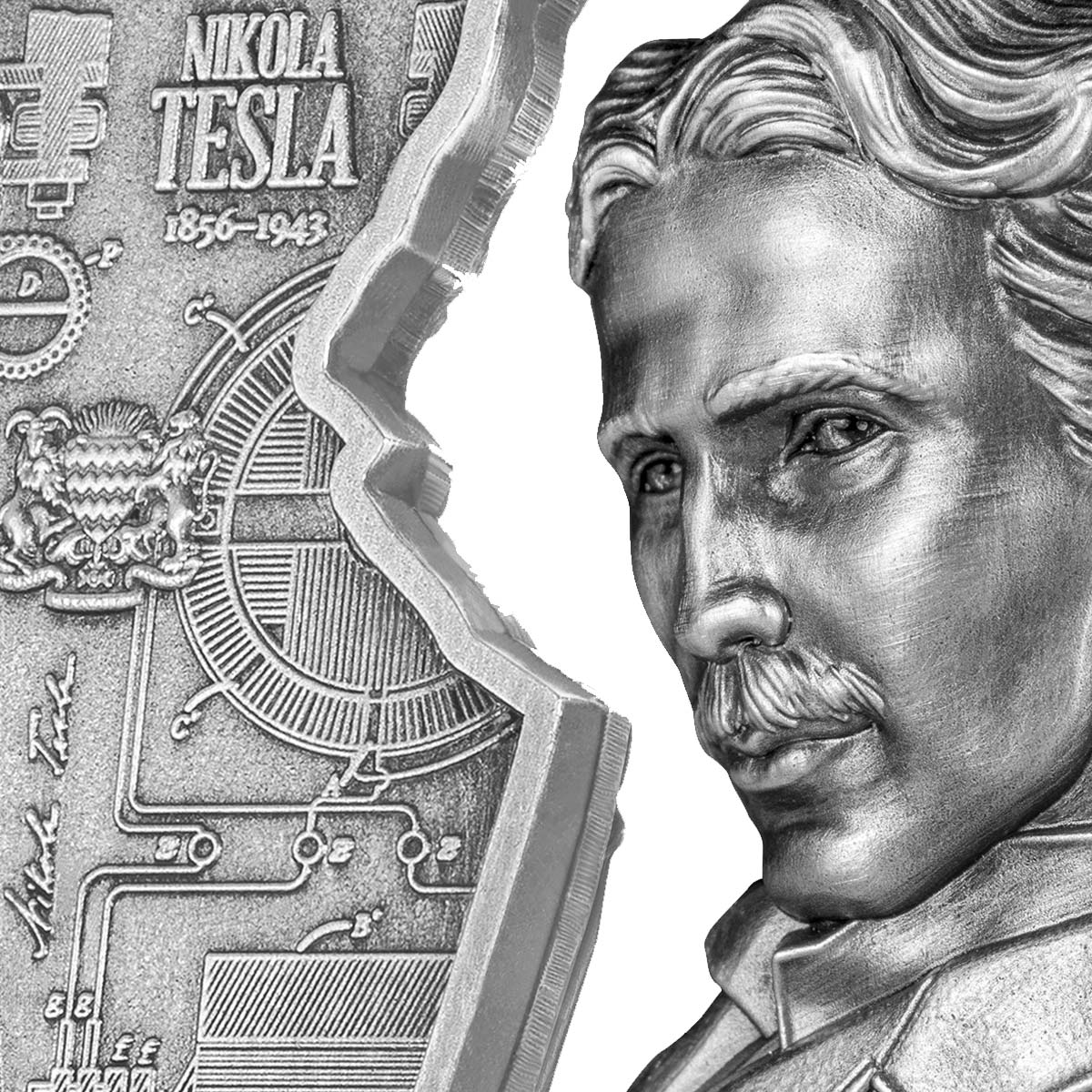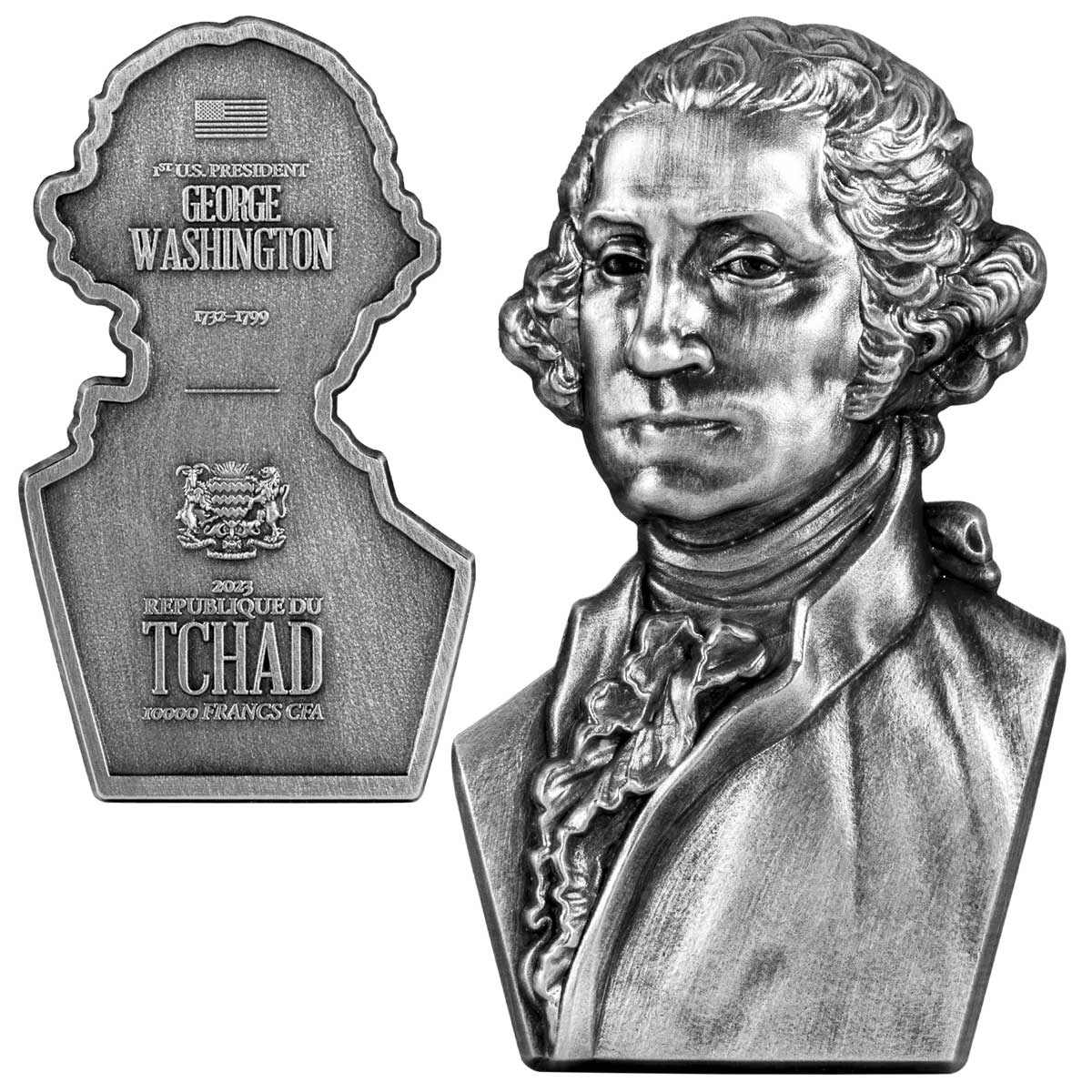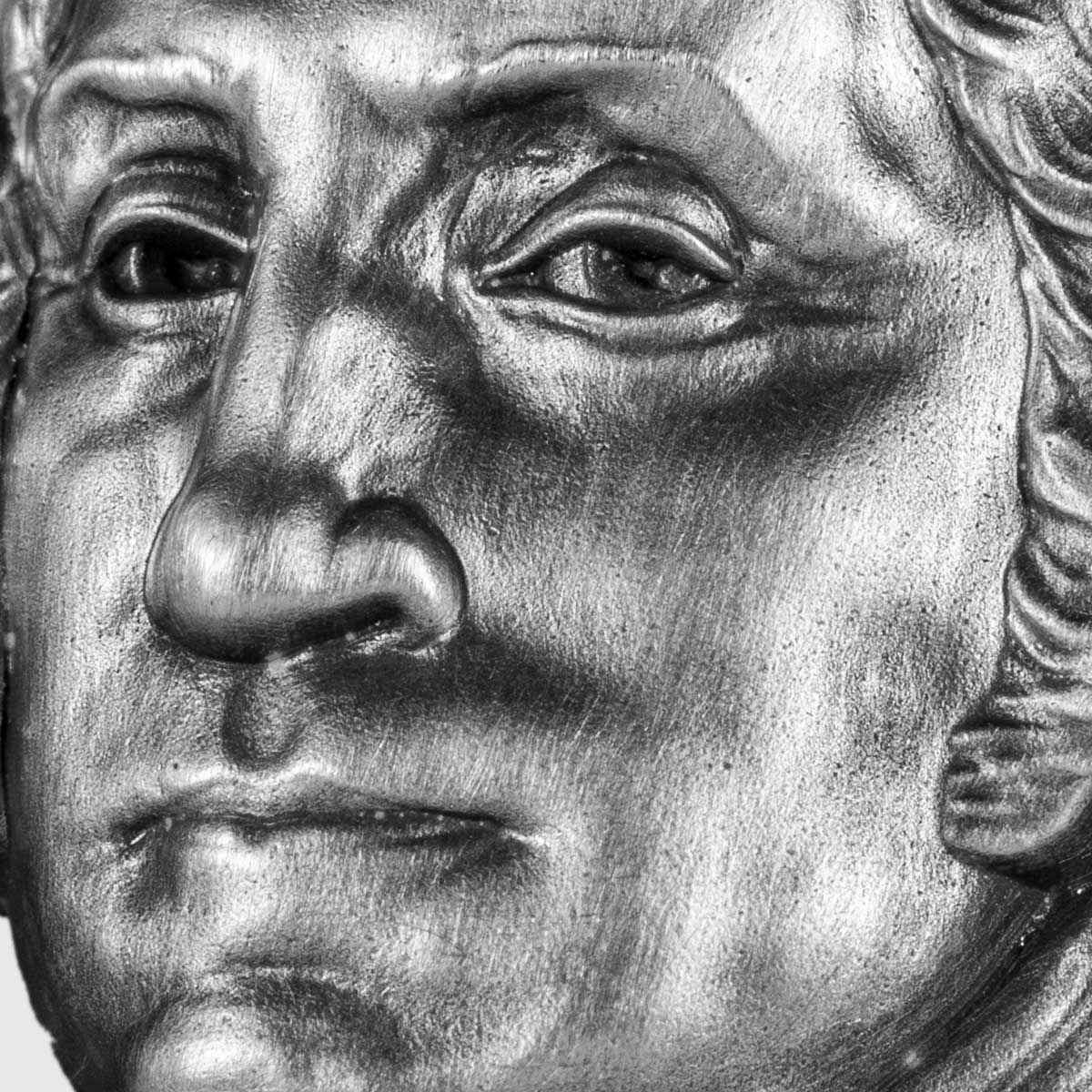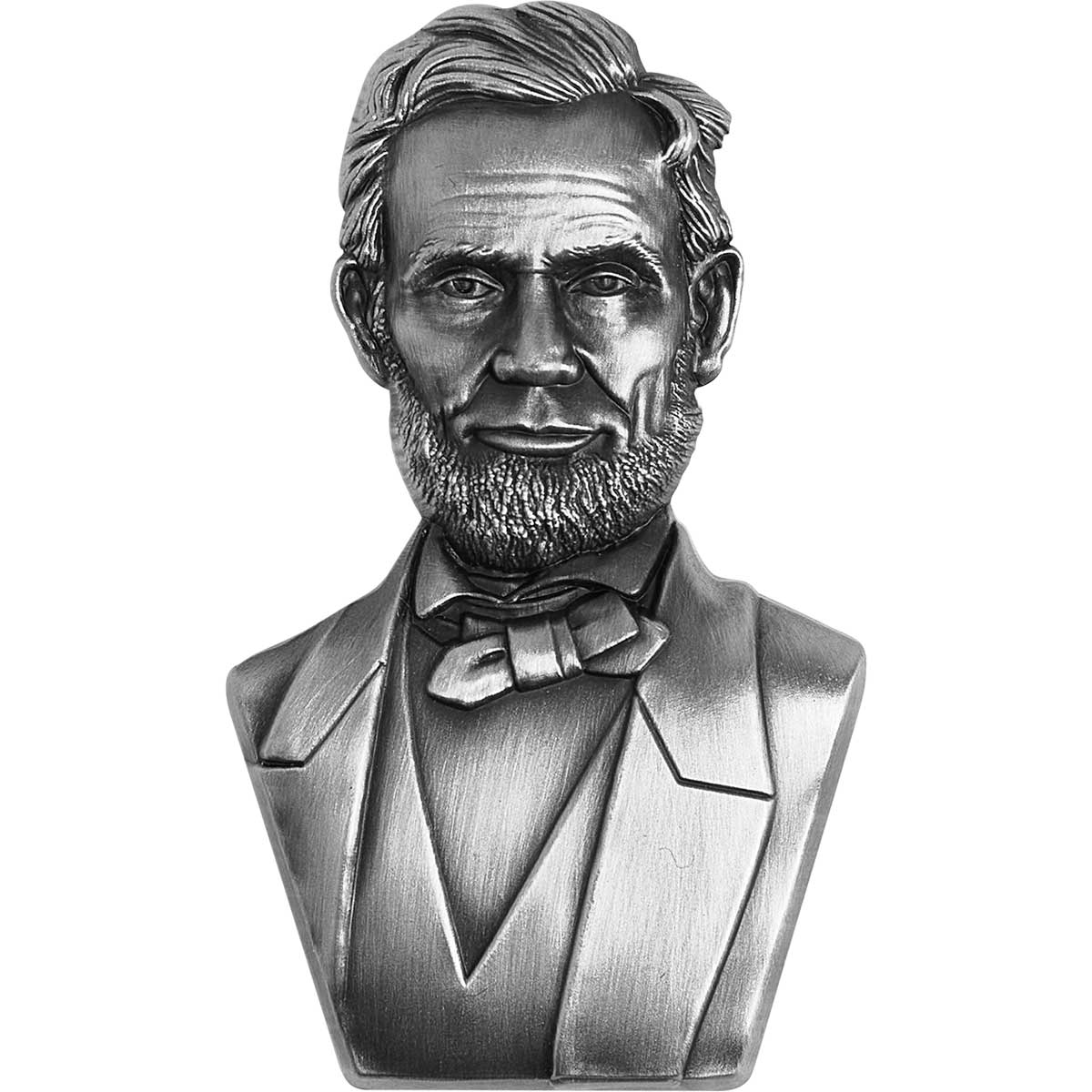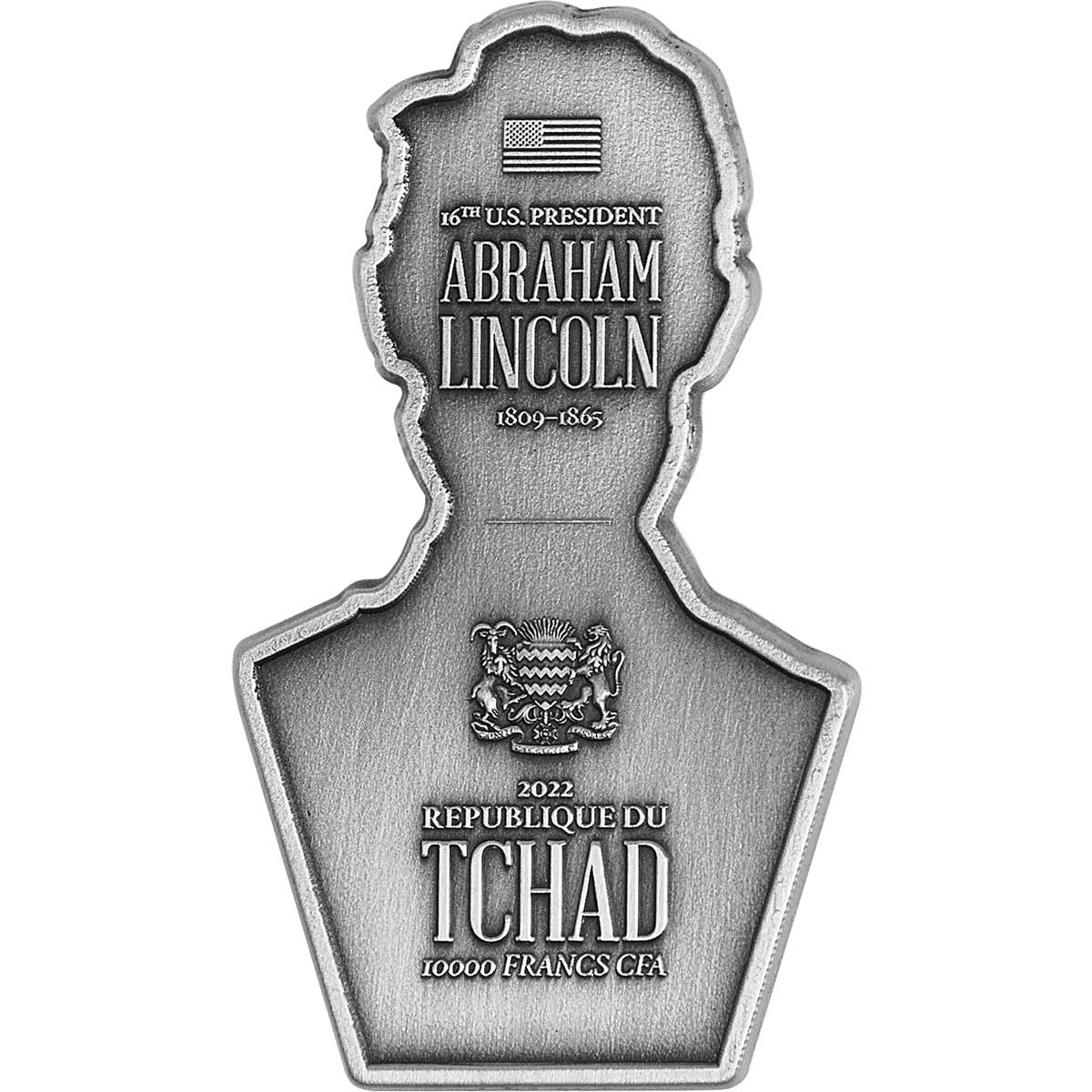FAMOUS HISTORICAL BUSTS (2022) by Precious Metal Collectors
We were extremely impressed when Precious Metal Collectors, most widely known for their silver over copper ‘Bi-Metal Max’ issues, debuted a new two-ounce silver coin in the shape of Abraham Lincoln. Eschewing any trickery, this was a solid silver coin, issued for the Republic of Chad, that was simply antique-finished. The star of the show was the incredible job that had been done, bringing a two-dimensional representation of a person into a three-dimensional piece of silver.
We suspect the coin was released to test market reaction, and it was obviously very positive, as we’ve seen a further six releases at the time of writing, which is impressive given it’s only been a year. Nor has PMC stuck with a single genre. While the second coin was also a United States President, they quickly moved to a more agile approach of dipping into various genres for their most iconic individuals.
People like Vincent van Gogh, Nikola Tesla, and Julius Caesar give you some idea of the broad selection in this range, and we’re great fans of this. Each coin is extraordinary in its realisation, and we can see nothing really negative in the finished articles. We’ve yet to get one in hand, but PMC provide good video and images, no renders here, but of the actual coins themselves.
As you can no doubt tell, we’re huge admirers of this series. It’s clearly well realised, the choice of subjects are wide, both in their respective fields, and in historical period, and they’re well presented with small mintages. Hopefully, the series will continue. We’d be very interested to hear who you’d like to see in the series, so drop a comment below with your suggestions. Personally, I’d love to see Queen Elizabeth I, King Henry VIII, or Winston Churchill, with decent source materials available for all.
A controversial religious figure is the latest, seventh issue in the series. Mother Teresa benefits from accurate and copious source material, and as a result, the depiction is spot-on. The layered clothing is particularly impressive, as is the wrinkled face. The obverse has some light theming. An impressive addition, if you like the subject.
MINTAGE 389, DIMENSIONS 30 x 50 mm
Mother Teresa is someone that nearly everyone around the world has heard of. This Roman Catholic nun is one of the most famous missionaries that has ever lived. She spent most of her life in Ireland and India, where she worked hard to maintain a religious congregation and charitable efforts in many places in the world. Mother Teresa heard the call of Jesus when she was on a train to Darjeeling that told her to leave the school she was working for and found a ministry. She founded the Missionaries of Charity, and this group became the focus of her work for the rest of her life. She would later create one of the leading charities to work to treat leprosy in India. This might be the work that she is most famous for.
Mother Teresa also undertook charitable work after the Chornobyl disaster and also assisted with hunger in Ethiopia. She worked with earthquake victims in Armenia as well. She opened various branches of her missionary before she passed away. She was granted many awards for her efforts around the world, and she accepted these accolades with humility and grace. Mother Teresa is one of the most important missionaries who has ever lived, and she deserves to be commemorated.
The sixth coin returns to historical leaders, but from a far different age, A personal favourite, Julius Caesar is perfectly brought to life, considering the shaky source material, and looks exactly how you imagined. The change from cloth to decorated armour has proven no problem to the sculptor, and only a bland obverse, although still a neat and appropriate one, is a negative.
MINTAGE 396, DIMENSIONS 30 x 50 mm
There is no famous person more controversial or interesting than Julius Caesar. If his own actions in his life had not already made him famous around the world during his own life, Shakespeare’s representation of him in his plays would have been enough to cement Caesar’s fame for good. Julius Caesar still stands for a sense of reckless accomplishment and personal bravery even today, and nearly everyone alive has heard of this famous Roman. The likeness for this piece is modelled after the famous bust of Julius Caesar that was created by Andrea di Pietro di Marco Ferrucci from 1512-1514. The delicacy of the carving and design in the marble bust is astonishing, and this piece is held up as one of the best examples of Caesar’s image created long after he was alive.
The renderings of famous Romans that were done long after they had passed away are hindered by intrusions of lore, legend, and the standards of beauty that were popular at the time that the artist was creating works of art. While this might not have been how Caesar looked, the drama and impressive nature of this rendering certainly communicate the power that would have surrounded Caesar like a cloak.
Issue five jumps to the music world, and continues the practice of picking the most recognisable images within the chosen genre. Mozart is beautifully done, with enhanced detail everywhere. The music notation obverse is a great addition.
MINTAGE 331, DIMENSIONS 30 x 50 mm
Known for creating pieces full of melodic beauty and formal elegance, other composers and artists revered the works of Mozart for their richness and their harmonic texture. Mozart was a child phenom and quickly rose to fame in Europe. His parents toured Europe, using Mozart and his equally talented brother as a means to generate funds and connections. This slightly unhappy experience did not make the family wealthy, but it did make Mozart well-known. The composer sadly died young at 35, but he was already one of the most famous composers of his day upon his untimely death.
This portrait of Wolfgang Amadeus Mozart is posthumous, but it is considered one of the finest examples of his likeness. This work was created by Barbara Kraft in 1819, which was long after the musician and composer had died. Pictures of the composer were sent to Kraft, who created her famous work based on these images. Relatives stated that this image was a very good likeness of the composer, and there is a similar image that was painted 40 years before that does appear to be quite similar. Mozart deserves no less than a true-to-life rendering as he was and is such an influential and famous composer both in his own day and today. The Obverse features the musical composition of Mozart’s Piano Sonata No. 11 in A major, K. 331.
For the fourth issue, PMC changed fields again, starting a trend that continues onward. The art world is represented by Vincent van Gogh, along with Salvador Dalí, about as iconic a visage as you can get with artists. Given the eclectic nature of the source material, the depiction here is particularly outstanding, and the patterned obverse is a fine touch.
MINTAGE 303, DIMENSIONS 30 x 50 mm
Van Gogh is arguably one of the most famous impressionist painters, and his works are well-known for their lovely brushstrokes and their sense of colour and movement. Van Gogh was a man who struggled with his mental health for almost all of his life, yet he still managed to create works of art that transcend generations. His self-portraits are among the best-known and beloved of his works because they reveal so much about what the artist saw within himself. In a day when photographs were not yet common, Van Gogh’s works depicting himself show us a lot about the painter.
This self-portrait was part of a series of 32 that Van Gogh created over ten years. This particular work was completed in September 1889, and it might be his last self-portrait. He was just about to leave Southern France, and the fact that he had created this image of himself indicates that he was once again without a model for his works. He often created self-portraits when he was not working on other pieces.
Moving away from the presidents for the first time, the third coin depicted Nikola Tesla. We’re definitely beginning to see a small uptick in the level of detail, particularly with the clothing texture. We’re also seeing more extensive theming of the obverse, with a superb engineering design here.
MINTAGE 369, DIMENSIONS 30 x 50 mm
Nikola Tesla was an inventor who was endlessly curious and who is credited with being one of the earliest pioneers in sustainable energy technology. He was the creator of the first alternating current induction motor, which made him a fortune that he then lost over the course of his life. He is credited with the invention of the Tesla coil, and he was also instrumental in the creation of safe and stable indoor lighting that changed the way that people experienced day and night. His lighting solutions also changed the way that factories operated during the winter. Arc lighting that he helped to invent made city streets safer at night as well.
His long-term and very well-known rivalry with Thomas Edison led to his interest in a different kind of current. To create a different kind of electrical solution than Edison’s direct current became Tesla’s passion, and he was eventually successful. This was a matter of pride for Tesla, who felt like no one believed in his inventions. This piece of art is based on a well-known photograph of Nikola Tesla that was taken in 1890 when Tesla was 34. The slightly arrogant smile and direct gaze that is captured in the image are in keeping with the way that most contemporaries remembered Tesla.
The second coin continued the US President’s theme, with that other most iconic of individuals to hold that office, George Washington. It’s an equally accurate depiction based on the available sources and carries on with that lightly themed obverse.
MINTAGE 355, DIMENSIONS 30 x 50 mm
George Washington was a complicated man who many historians have tried to summarize in simple ways. He was a slave owner, but he also believed in assimilating others into the culture that was being created in the fledgling country he helped to build. He was a military hero, but also a man who would have been happy just being a farmer for all of his life. Washington has long served as an example of a politician and leader by necessity, a cornerstone concept within American society with its citizen military. Washington has long been revered as the first and possibly the best of the American presidents, and his legacy can be felt even today in the United States.
George Washington’s image was popular starting in 1775. This was the year that he was named the commander in chief of the continental army and became a symbol of hope for the fledgling nation just trying to spread its wings. This famous portrait was done by Gilbert Stuart, and it remains one of the most famous representations of the man who helped make the formation of the United States a reality. Stuart made many renderings of the United States’ first president, and these images helped secure the foothold that he needed to be a successful painter.
The debut coin certainly hinted strongly at the validity of this concept. The depiction is quite excellent, and a classic, recognisable one at that. The obverse is yet to take on the heavier theming that later issues have, but the roots of it are present. These are the only two images we have of this one, unfortunately.
MINTAGE 364, DIMENSIONS 30 x 50 mm
The 16th President of the United States was born in 1809 into a poor family in Indiana. He became a lawyer and ran for state legislator and later US congressman. He was frustrated as a lawyer by the addition of slavery states through the Kansas-Nebraska Act, and decided to re-enter politics and run for president. He would spend most of the years of his life helping the North to survive the Civil War.
Lincoln is famous for trying to resolve the tensions and heal the war-torn US after his re-election. His efforts were cut short by his assassination by John Wilkes Booth in 1865 at Ford’s Theatre in Washington, D.C. Whether he was loved or hated by people in the US, his loss was felt keenly as the war-torn US limped along at his death. Many of the worst offences and problems of the reconstruction process are attributed by some to the loss of Lincoln’s guiding wisdom for the country.
Famous for the Gettysburg address as well as having a large monument devoted to him in D.C., Abe Lincoln has long been associated with fair leadership and a vision for the future that many politicians lack. He was considered a common man who helped to guide the US with care through one of the most devastating wars of its history. His work is still quoted, and he still stands for these values in the minds of many Americans today.


